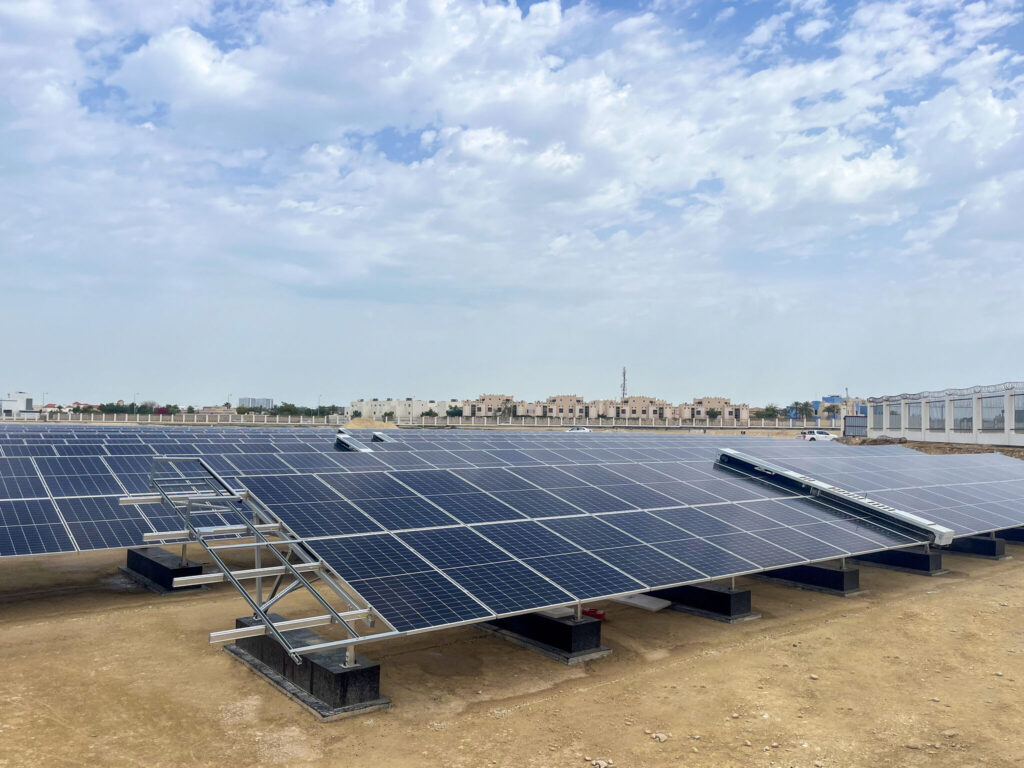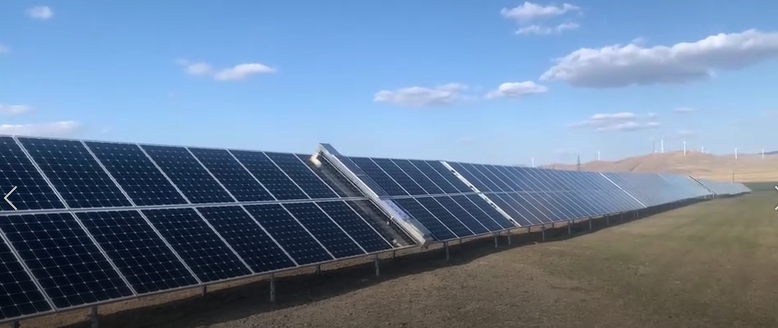With the rapid expansion of solar energy infrastructure, maintaining optimal efficiency of photovoltaic (PV) panels has become critical. Dust, sand, and environmental pollutants can reduce solar panel efficiency by 10–65% depending on regional conditions. Traditional manual cleaning methods, plagued by high costs, safety risks, and water dependency, are increasingly inadequate for large-scale installations. This article explores the design, advantages, and technological innovations of automatic solar panel cleaning systems, focusing on a cutting-edge waterless robotic solution designed for industrial applications.
1. Core Features of the Automatic Cleaning System
The described equipment represents a paradigm shift in PV maintenance, combining automation, intelligence, and sustainability:
ประสิทธิภาพการทำความสะอาด:
- เทคโนโลยีการกวาดแห้ง: Utilizes ultra-flexible PA610 nylon brushes to remove >98% of dust without water, minimizing damage to panel surfaces.
- Adaptive Speed: Brush rotation adjusts between 60–120 RPM based on dust type and weather, ensuring optimal cleaning across diverse environments (e.g., deserts, urban areas).
- Self-Cleaning Mechanism: Post-task, brushes run at high speed to eject residual dust, extending their lifespan.
Operational Parameters:
- Range: Covers 1,600–3,000 meters per session.
- Battery & Power: 24V/16Ah battery with 55W panel power for continuous operation.
- ความทนทาน: Operates in -30°C to 70°C, IP65-rated for dust/water resistance, and climbs slopes ≤22°.
2. Advantages Over Traditional Methods
2.1 Economic Benefits
- Labor Cost Reduction: Eliminates the need for manual labor in hazardous environments (e.g., rooftop or desert installations).
- Lower Maintenance: Regular automated cleaning prevents micro-cracks and hotspots caused by debris, extending panel lifespan.
- ROI Enhancement: Users report a 10–65% increase in power generation post-cleaning, significantly boosting revenue for large plants.
2.2 Safety and Environmental Impact
- Risk Mitigation: Removes human involvement in high-altitude or extreme-temperature cleaning.
- การอนุรักษ์น้ำ: Dry cleaning is ideal for arid regions, avoiding the high water consumption (e.g., 1 ton/MW for manual washing) and chemical runoff of traditional methods.
3. Intelligent Management Capabilities
The system integrates advanced IoT and AI-driven features for seamless operation:
- รีโมทคอนโทรล: Operate via mobile app or web interface, with real-time monitoring of cleaning progress and energy consumption.
- Automated Scheduling: Algorithms adjust cleaning frequency based on environmental data (e.g., dust accumulation rates, weather forecasts).
- Fault Diagnostics: Cloud-based platforms enable rapid troubleshooting; 90% of minor issues (e.g., brush jams) are resolved remotely.
- การอัพเกรดตลอดอายุการใช้งาน: Software updates ensure compatibility with evolving PV technologies and operational needs.
4. Applications in Industrial Settings
- Desert Solar Farms: Combats sand accumulation without water, critical in regions like the Middle East or Gobi Desert.
- อาร์เรย์หลังคาในเมือง: Compact design avoids structural damage from manual cleaning.
- High-Pollution Zones: Mitigates soot and industrial residue in manufacturing hubs.
5. Comparison: Automated vs. Manual Cleaning
| Criteria | Automated System | การทำความสะอาดด้วยมือ |
|---|---|---|
| ประสิทธิภาพ | >98% dust removal; daily cleaning | Intermittent, labor-intensive |
| Water Usage | None (dry sweep) | 1–3 tons/MW per session |
| ความปลอดภัย | Zero human risk | Falls, heatstroke, electrical hazards |
| ค่าใช้จ่าย | One-time investment + minimal maintenance | Recurring labor + water expenses |
| ผลกระทบต่อสิ่งแวดล้อม | Zero wastewater | Chemical runoff risks |
6. Future Directions
Emerging technologies like AI-powered dust prediction and drone-assisted inspection are being integrated into next-gen systems. These advancements aim to further reduce energy consumption and enable predictive maintenance, solidifying automated cleaning as the cornerstone of sustainable solar energy management.
บทสรุป
The industrial solar panel cleaning system described here addresses the critical challenges of scalability, cost, and sustainability in PV maintenance. By leveraging robotics, IoT, and waterless technology, it ensures maximum energy yield while aligning with global decarbonization goals. As solar installations expand into harsher environments, such innovations will play a pivotal role in maintaining the viability of renewable energy infrastructure.

